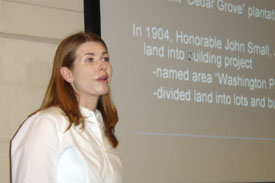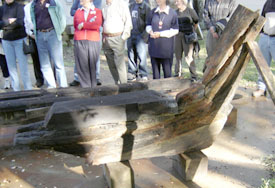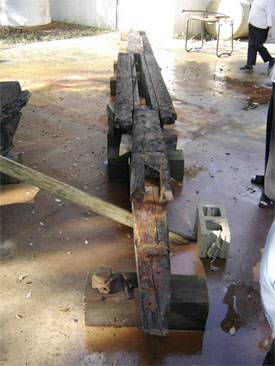ECU's 2006 Fall Field School
Project Journal
1 November 2006
By Tricia Dodds

This week was our “public outreach” week. Dr. Stewart and I were to present at the North Carolina Maritime History Council’s Annual Conference to tell everyone about the Fall Field School including the events in the field, the history of the surrounding area of the Washington Park vessel, and our findings so far. Since I attended the conference, I agreed to Calvin’s request that I trade spots with Joe and write the journal entry for the week. We all have to make our sacrifices in the name of science sometimes.

Tricia Dodds presents at the North Carolina Maritime History Council's Annual Conference
The conference, titled “Underground and Underwater: Where One Finds History,” was my first conference, and I was eager to meet so many people who were as interested in maritime history as I was. Of course, my presentation on the last day of the conference was looming in the back of my mind. Sure, I’ve presented a paper in one of my maritime history classes before, but this presentation, however, was different from all of my other experiences. This time I was presenting the original research we collected during field school to my colleagues in maritime history as the first presentation of my professional career. I’ll admit that I was more than a little nervous.
I left for the conference on Friday at a bright and early 5:30 a.m. The conference had actually started the day before, but I had to work late Thursday (poor graduate students still need to pay the bills) and could not leave until Friday morning. As I drove to Southport at the southern tip of North Carolina, I practiced my speech over and over in the car, trying to feel comfortable with the words that I wanted to say. I arrived in Southport just as the opening remarks were about to start followed by various presentations. As I listened to one speech after another that included World War II shipbuilding to the CSS Alabama, I was reminded of the plethora of maritime history in North Carolina. There is still so much more research that can be done in this area.

A portion of the Hilton wreck.
After the presentations, everyone boarded the Starship for an afternoon tour along the Lower Cape Fear River. Rain soon began to come down as we toured the historic river, but no one seemed to really mind. I suppose that maritime historians are used to getting wet at least every now and then. The hot cider onboard helped as well. After the tour, we ended the eventful day with a reception at the North Carolina Maritime Museum followed by another memorable presentation discussing archaeological excavations at various sites throughout North Carolina. By the time the day was over, I was ready for sleep-after I practiced my presentation a few more times in my hotel room.

Centerboard trunk and mast step of the Hilton wreck.
Saturday morning began with a ferry ride in my car across the Cape Fear River to tour Fort Fisher and the Underwater Archaeology Laboratory at Kure Beach. Dr. Stewart and I began with the lab tour, and we viewed a lot of artifacts recovered thanks to underwater archaeology. Of course, we were most interested in the centerboard schooner sitting behind the lab. Recovered from a river, the Hilton was not as large as the Washington Park vessel that we had investigated, but it was still similar. We looked over the frames and other parts of the Hilton, trying to understand the construction technique to perhaps apply to our investigation of the Washington Park vessel. Before long, the thirty-two pounder cannon at Fort Fisher was fired, signaling the end of our tour. Suddenly, that anxious feeling returned in the pit of my stomach-my presentation was next.
After Dr. Stewart discussed the vessels at Site A and B and the events of our 2006 Fall Field School, I gave my part of the presentation, beginning with the history of the area surrounding the Washington Park vessel. John H. Small, Jr., who owned the entire area in the early 20th century, developed the land and built houses on the property, which grew into its present, thriving community. The land where the vessel is located used to be owned by the Virginia-Carolina Chemical Company from 1916 to 1944, and this company manufactured fertilizer and even used watercraft vessels to ship the raw material and finished product. The land became private property and has remained a private residence ever since. Downriver from the site, the Pamlico Chemical Company ran a similar fertilizer factory from 1914 to 1924, and the Pamlico Shipyard operated on that same property from 1941 to 1944, building barges for the war effort. The commercial activity along the waterfront was quite immense.
Next, I discussed the possible circumstances that caused the demise of the Washington Park vessel. Based upon evidence including wooden piles, a shallow location, scarcity of portable material culture, and no definite evidence of rigging or propulsion, this vessel was most likely abandoned at this site. As we ended our presentation, Dr. Stewart and I were reminded of the questions that still remain for the Washington Park vessel even though we have already researched quite a bit. At least I survived my first professional presentation, and I think that I managed to convey my ideas to my receptive audience. No worries, right? The conference ended soon afterwards, and I departed for Greenville. Upon my return, I still have unfinished site plans and more research waiting for me, but this is all worth it in my opinion, even if I lose a little sleep over it every now and then.
For more information you can visit the ECU website at:
http://www.ecu.edu/maritime/index.htm
Return to Project Journal home page.

